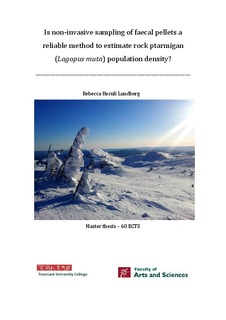| dc.description.abstract | The rock ptarmigan (Lagopus muta) is relatively poorly studied worldwide, and little is known about its population status, which in Norway is based on hunting statistics. In order to develop proper and successful long-term management measures for any species, as well as to avoid poor management strategies, reliable data on population size and density over time is crucial. Importance should therefore be given to develop and choose the most reliable and effective estimation methods that provide results with firm precision. Faecal pellets were collected in spring from 75 snow roosts at the Lifjell plateau in Telemark County utilizing line transect surveys. All 75 samples were collected from a total of 35 observations, each containing from 1 to 5 snow roosts. Genetic analyses were used to investigate species of all samples, and 14 microsatellites were used in the individual identification. The species analyses resulted in 32 samples (43%) to originate from rock ptarmigan, and 43 samples (57%) to originate from willow grouse (Lagopus lagopus). The 32 rock ptarmigan samples originated from 28 different individuals due to re-sampling of one female which was sampled twice, and one male which was sampled four times. Estimated population density based on all 75 samples was calculated to be 2,66 birds per km2, while estimates based solely on rock ptarmigan samples was calculated to be 0,99 rock ptarmigans per km2. This suggest that estimating rock ptarmigan density by counting roosts will lead to a biased estimate, as the roosts are likely to originate from willow grouse. In Lifjell willow grouse habitat extend into rock ptarmigan habitat, leading to a mixing of roosts. Counting roosts therefore, presuming all are from rock ptarmigan, overestimates the rock ptarmigan population. Including genetic testing still provides a poor estimate, as it underestimates the population when compared to the counting of territorial males as performed in an unpublished study by Darrud & Storøy. This makes the method unattractive for field managers, as it provides erroneous estimates, is expensive, and demands laboratory knowledge. This, however, may not be the case in scenarios where no overlap between rock ptarmigan and willow grouse is present, either in other areas or at different times of the year. | |
